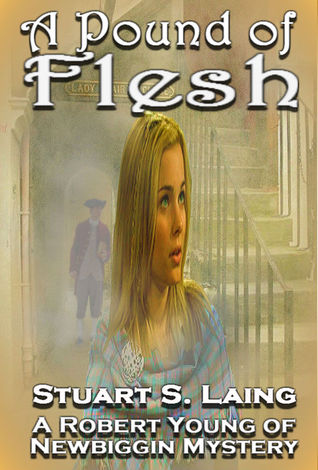Writing a story is an art in itself. Creating the right setting, the perfect characters, plot, believable dialogue and conflict. With those blended ingredients are what makes a story impact the reader’s imagination, mind and heart. The most important aspect of story-telling is to draw the reader in your character’s world. How are the stories written to do this and how does one make it work? Today, writer Stuart S. Laing, author of the, The Robert Young of Newbiggin Mystery Series shares with us his expertise.
First of all, please allow me to thank you for giving me the opportunity to join you today. It is always a pleasure to spend some time discussing writing with someone who works tirelessly to promote writing and authors. -Stuart
What are the steps in creating a setting for your story?
As a real estate agent might put it: location. Location. Location.
As I write a series of murder mysteries set in Edinburgh, Scotland during the 1740s I enjoy trying to take the reader back to what, for some, are familiar streets but create a picture of how they were almost 300 years ago.
Fortunately, I have several maps from the period which are invaluable to me when moving my characters around the old town.
I am also lucky in that Edinburgh is only a short train journey away so I can walk the routes my characters take. It both lets me know how long it takes to walk from the gates of Greyfriars Kirk to the entrance to Edinburgh Castle for example, but also just being in the heart of the Old Town never fails to inspire ideas and fresh plots.
There is a fine line between creating a visible backstory and a hidden backstory of your characters. What are the steps in balancing it out? What should you not do?
I’m not sure that there is a definite rule of how much, or how little, backstory you should share. Again in writing a series of books you can drop mentions of events and people into one story which only becomes important in another.
 An example of this would be the character of Estelle Cannonby. She, and her younger sister, are introduced as runaways from the workhouse in the first book A Pound of Flesh but the true story of how they ended up being placed in the care of that place only becomes clear in Jezebel’s Chains, the seventh book .
An example of this would be the character of Estelle Cannonby. She, and her younger sister, are introduced as runaways from the workhouse in the first book A Pound of Flesh but the true story of how they ended up being placed in the care of that place only becomes clear in Jezebel’s Chains, the seventh book .
What should you not do? That’s a tougher one to answer. Speaking personally I would say that if you are going to hint of something really important having happened several times to a character in the past, but never explain what that was it would be a no-no. There’s no point in dangling a lure before the reader but never allow them to grab it. It would be like reading a murder mystery where in the final scene the detective opens an envelope to find a note naming the killer but the author doesn’t tell you whose name is in there.
How much is too much conflict? And what do you do about it when it’s not working in the plot?
I think there could only be too much confusion for readers if you had so many subplots mixed in with the main plot that lines become blurred. Character A is in loved with Character B, but B is secretly in love with character C who is plotting to kill Character D who is in love with A while plotting to kill B and C. Meanwhile characters E, F and G are sitting in a small room smoking cigarettes and discussing the history of steam trains, but all these are subplots to the main plot which is about a gang of international art thieves (characters H, I, J and K) planning on robbing the Louvre in Paris. I think a book with all those threads going on could become a tad confusing to say the least.
I think two, or perhaps three subplots would be enough for any single story.
For the second part of the question, if something isn’t going to plan then you need to step back and take a long hard look at why it isn’t working. In extreme cases there may be no choice but to scrap an entire thread and just start again. Usually though it may be that you just need to change the approach you have taken. Even a slight change in emphasis in a single scene can unlock the whole thing for you. New avenues are opened and pieces start to fall neatly into place.
What are the steps in creating believable characters and dialogue?
Shading is the simple answer. No’one is either all good or all bad. I bet even Mother Theresa had days when she felt a bit miffed with life in general. If you have a character that is so sugary sweet that even Disney Princesses find them nauseating your reader will soon get tired of them. Likewise if you have a villain who is so monstrously cruel without a single shade of light to his darkness it won’t work either.
People from all walks of life are never simply good or bad. We all know at least one person who just rubs us up the wrong way at times, but very few of us will know someone who does that constantly and without even once just simply being there, minding their own business and not filling us with the urge to chop them up and bake them in a pie.
Believable characters are those we can relate to in some way whether they are good or evil. There is something about them that makes us go ‘yup, I know how you feel.’
As for dialogue, I think it is important to avoid using words or phrases which are out of place, admittedly this is more of an issue in historical fiction than contemporary fiction. If you were reading a book about the Pilgrim Fathers and they started talking about ‘First Nation People’ you might be left scratching your head and asking if that is how they really referred to the chaps firing bows and arrows at them.
Also, if you are going to use location specific language (such as Scots) then either include a glossary to help out the reader or use it in a way which allows them to figure out what is meant.
What is the advice you would give to a writer when they get stuck on a specific scene or comes across a road block in their plot?
As I mentioned earlier sometimes the best thing to do is take a step away. Listen to music, watch some TV, read a book or go for a walk. Anything that takes your mind off obsessing over why that scene isn’t working. I find that sitting staring at a computer screen rereading the same few paragraphs over and over, cursing why they make no sense is the best way to make sure you’ll just become even more frustrated with it.
Take the time to clear your mind and then go back to it. Sometimes a little distance is all you need to see things more clearly.
Another idea is using the voice recorder on your phone. Become the characters in the scene. Talk out loud. Don’t think about what happens next, just let it happen organically. Dialogue, setting, what they see and hear, just natter away into your phone as it comes. Afterwards you can listen to it and pick out what works from it all.
Jings, I thought these questions would be simple! You have a nasty habit of making us work in finding an answer.
Thank you again for allowing me to spend some time with you. Three cheers for Indie Brag and Layered Pages, and especially three cheers to you Stephanie.
Thank you, Stuart!
About Author:
Born and raised on the east coast of Scotland in the ancient Pictish Kingdom of Fife Stuart grew up looking across the Firth of Forth towards the spires and turrets of the city of Edinburgh and its castle atop its volcanic eyrie.
He has always been fascinated by the history of Auld Reekie and has spent most of his life studying Scottish history in all its aspects whenever he finds the time between family, work and the thousand and one other things that seek to distract him.
Despite the vast panorama of Scotland’s history, he always find himself being drawn back to the cobbled streets of the Old Town. Those streets have provided the inspiration for his stories and characters.
He would urge all visitors to Scotland’s ancient capital to (briefly) venture into one of the narrow closes running down from the Royal Mile to get a flavour of how alive with mischief, mayhem, love and laughter these streets once were.
Stuart’s Character in Motion-Two Sides of A Coin at Layered Pages
Book Links:
In the UK, please visit

Thanks Stuart for the interesting discussion, having read all of Stuarts books I can honestly say he is a fantastic author and has a real flair for the descriptive, I always can practically smell and taste the surroundings of Auld Edinburgh a City I too know very well and love, but his characters well I have my favourites obviously, but always very well written and excellent stories,very highly recommended author.